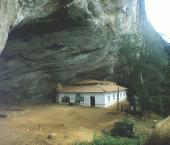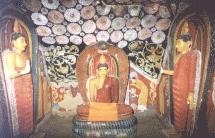






Yatigama is a little village in Bulathsinhala just a two-hour drive from Colombo. Yet few are aware that in this hamlet is a cave belonging to the stoneage period dating back more than thirty thousand years, and known to be the most ancient pre-historic settlement sites in the whole of Asia.
Fa-Hsiengala, the rock cave temple, commonly known as Pahiyangala among villagers is found in a very tranquil environment. Surrounded by trees, this massive rock holds much importance both religiously and historically. It is known to be the only natural cave of this size to be found of the Mesolithic period and also bear testimony to ancient foreign links Chinese Buddhist monk and explorer Fa-Hsien is believed to have lived in this cave.
The entire rock is about 610 feet high, located 1400 feet above sea level. The cave itself is about 15 feet high an 147 feet wide. Villagers say about 3000 people can be accommodated within, and though from the outside it does not seem that large, once inside its size is clearly visible. The entrance takes the shape of a half circle, the reason for this being the South West monsoon winds, which blow in that direction, hollowing the rock.
The present incumbent of the temple, Ven. Yatigampitiye Chandima Himi is well versed in the history of Fa-Hsiengala. "Since it is a natural cave, it's exposed to the wind and other elements. Excavations carried out by the Archaeology Department have revealed the different layers visible in the rock formation over the years", he says.
"The cave interior never gets wet, unlike in other caves where water sweeps in from the top. Throughout history there has been no water inside Fa-Hsiengala. In most caves a drain is cut at the entrance so that water does not come in but here there is nothing like that", said Chandima Himi.
Historians have found evidence of pre-historic settlements at Fa-Hsiengala which reveals that this cave had been home to humans belonging to the Mesolithic period. Two skulls were found during excavations, one dating back to more than 6000 years.
"The skulls were examined by Professor Kenneth Kendy from Cornor University USA, who also carried out tests on the Balangoda pre-historic settlements. Excavations revealed more and more facts about our ancestors. Hundreds of snail shells were found, giving rise to the theory that this would have been their staple food. Fire had been in use even during this period and heaps of charcoal were also discovered. As they had used stones as weapons most of the snail shells are partly damaged. Hunting animals using these weapons must have been difficult thus one can surmise that they would have settled for snails", explained the monk.
"Most of the findings are displayed at the cave temple and many would be astonished at the condition of these artifacts, which are well preserved. "It's because the ground never gets wet" the monk added.
Legend has it that during the 5th century the Chinese monk Fa-Hsien took shelter in this cave on his way to Adam's Peak. History reveals that the monk had lived in Sri Lanka for about two years visiting various places in the island. A book written by Fa-Hsien does mention his visit to Lanka and what he saw but does not reveal where he lived. "Although there is very little evidence to say that he had actually lived here, the fact that the cave was named after him is enough. We also discovered a Chinese ceramic plate, which we believe, belonged to the priest. The Chinese too firmly believe that the priest had lived here. It is their government that presented us with a massive picture of the priest, and a community village was built at Yatigama" explained the monk.
However, it is only during the Kandyan period that this cave was made a Buddhist monastery. The shrine room built by the Porogama Bhikku with its statues and valuable painting of that period still remains intact. This priest who was somewhat of a giant had built the temple were also placed by him.
A footpath at the side of the cave has the most fascinating sight, a natural pond which never goes dry. Even during the most severe drought water is found in plenty here. Tiny caves are also found around the main cave. But upto date these have not been excavated.
Though excavations were began, at the moment work has come to a stand still, due to a lack of funds. No definite date has been given for the work to recommence. However Chandima Himi with the minimum facilities has already started building a museum to provide information about the Mesolithic period.
At present the monastery has 49 priests yet according to the priest survival in this remote village is difficult. Providing meals for the 49 priests is their main problem.
"Although it is the duty of the villagers to provide 'Dana' to the village temple, in Yatigama it's a different story. They themselves don't have the means to feed themselves so we can't expect them to feed 49 priests. But life goes on", Chaminda Himi says.
Life will certainly go on with Fa-Hsiengala unfolding divine aspects of history, if more interest is focused on its treasure trove of the past.
The recent past of St. John's has not been rosy but the bungalow seems to be waiting for visitors so that it wil once again be admired. After all, even an elderly lady enjoys the flattery of people.
Not all plantation bungalows are shrines of neatly-ordered middle class domesticity. The occupants of most plantation bungalows are neither affluent nor as traditional as their predecessors. They live in the bungalow because it is the accommodation assigned to them by the plantation management company.
An assistant superintendent is usually the tenant of a bungalow that is less distinguished than that of his boss, the plantation superintendent or manager. If the assistant superintendent is a bachelor with only his salary to live on, he is unlikely to be able to lavish much care and attention on his bungalow home. Nor does he need to, since plantation guests are likely to be accommodated in the superintendent's bungalow, not his.
These remarks serve as introduction to the kind of bungalow that assistant superintendents and plantation juniors inhabit. Like the bungalow at St. John's Estate, such buildings have seen better days. St. John's is located just above the main road linking Kandapola with Ragala. In the days when it was owned by the Nuwara Eliya Tea Estates Company Limited, it was obviously a fine, if small, property. After the estate's period as a division of the State Plantation Corporation's Nuwara Eliya group, it is now under Aitken Spence Plantation management in the Concordia Group. The recent past of the St. John's bungalow was obviously not rosy. Yet although the property shows its age, it retains an aura of dignity and charm, like an elderly lady of character reduced in circumstances.
The delight of the bungalow exterior is the medley of bay windows, complemented by a conservatory-like porch at its front door. With windows on the windward side, and unadorned columns on the other, it would be a joy to a horticulturally-minded housewife to fill with potted plants.
The transom of the windowed front doorway supports a seven-petalled fanlight, adding grace to the bungalow's small entrance hall. The three bay windows of the front define a corner room, with French windows, the dining room and, on the right of the entrance, the living room. The wooden floor boards sag under foot and even the solid walls show signs of crumbling with old age. The bungalow is of classical colonial vintage, pre-dating the more modern bungalows of the 1920s which are its hilltop neighbours. Its ceilings are of boards, and boards (painted cream instead of being left their natural wooden finish) panel the lobby and corridor from floor to waist height.
The corridor is long, linking the living room with the kitchen and staff quarters. Natural light floods in through the skylight, windows set into the slopes of the roof. Ceiling beads are painted black; the underside of the roof is of painted boards too.
There is a fireplace in each room. The one in the guest room is a simple, wooden faced one with slender wooden supports for its wooden mantle piece. An old electric fire lies by the grate. The bathroom has a door opening onto the back verandah which links three rooms.
The master bedroom extends the length of the opposite side of the house and boasts two more bay windows. Its interior doors, wood panelled now, were once graced with window panes.
Although it is ancient, the features of the St. John's bungalow are still handsome. It would not take much to revive the building's flagging personality and make it a highly desirable country home.
As with most plantation bungalows, the occupant of St. John's keeps it ready for unexpected visitors. The bungalow seems to be waiting for them, so that it will be once again appreciated and admired for what it is. After all, even an elderly lady enjoys flattery and the company of young people.
Continue to Plus page 2 - The cost of the bell * Then everything went dark







Please send your comments and suggestions on this web site to
info@suntimes.is.lk or to
webmaster@infolabs.is.lk